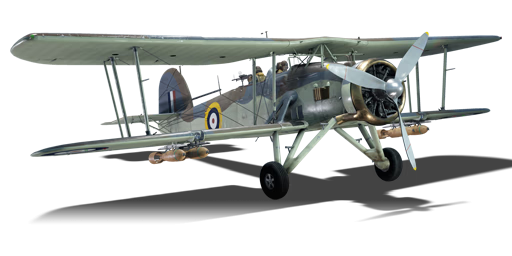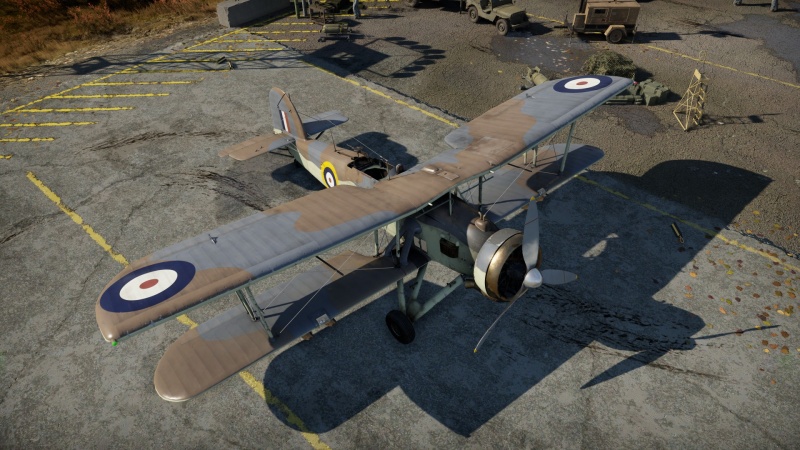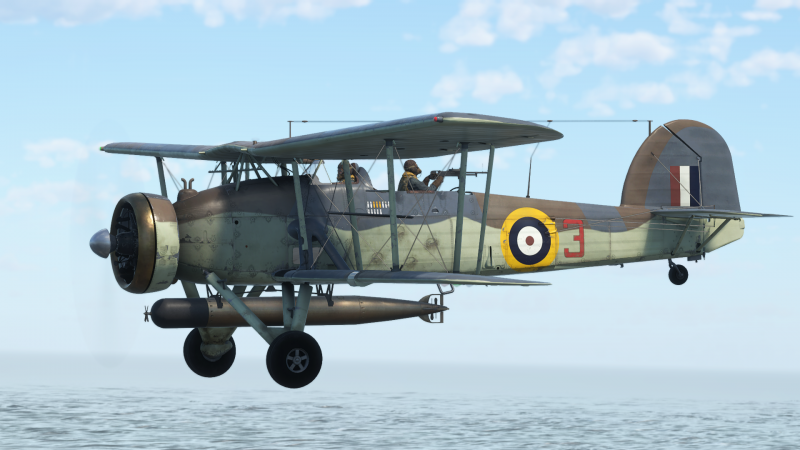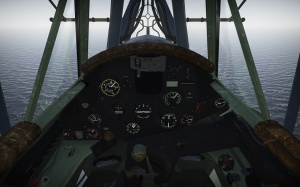Difference between revisions of "Swordfish Mk I"
(→Description) (Tag: Visual edit) |
m (Specs-Card ArtImage Added) |
||
| Line 6: | Line 6: | ||
{{Specs-Card | {{Specs-Card | ||
|code=swordfish_mk1 | |code=swordfish_mk1 | ||
| − | |images={{Specs-Card-Image|GarageImage_{{PAGENAME}}.jpg}} | + | |images={{Specs-Card-Image|GarageImage_{{PAGENAME}}.jpg|ArtImage_{{PAGENAME}}.png}} |
}} | }} | ||
Revision as of 05:10, 4 March 2023
| This page is about the British bomber Swordfish Mk I. For the premium gift version, see Swordfish Mk II. |
Contents
Description
The Swordfish Mk I is a rank I British bomber with a battle rating of 1.0 (AB/RB/SB). It has been in the game since the start of the Open Beta Test prior to Update 1.27.
The Swordfish is a plane often overlooked by new players, but it is common for more experienced players to hold a special love for "ugly ducklings". As such, the Swordfish is valued for providing a change of pace towards slower gameplay and simultaneously a challenge, being mostly staying alive.
As with all torpedo bombers, maintaining low altitude, high speed, and fighter cover are all recommended. The optimal distance for launching a torpedo is 1 km from the target, though the Swordfish is slow enough to be able to drop torpedoes efficiently from shorter distances. Targets should be engaged from directly ahead or astern, making "leading" the target much easier.
If torpedo bombing is not an option, the plane can carry bombs for attacking ground targets. The aircraft's slow speed means it is great practice for aiming bombs. With practice, any pilot can make short work of tanks and light pillboxes with the Swordfish.
The Swordfish is an in-game oddity because it can exceed its max altitude of 3,300 m and go up to about 4,000 m with the 4 x 250 lb bombs attached.
A classic biplane design, thus offensive armament is limited. Restrained to only one machine gun offensively and defensively, the Swordfish's true strength is its payload.
General info
Flight performance
| Characteristics | Max Speed (km/h at 1,400 m) |
Max altitude (metres) |
Turn time (seconds) |
Rate of climb (metres/second) |
Take-off run (metres) | |||
|---|---|---|---|---|---|---|---|---|
| AB | RB | AB | RB | AB | RB | |||
| Stock | 208 | 200 | 3300 | 14.0 | 15.1 | 6.4 | 6.4 | 297 |
| Upgraded | 246 | 226 | 12.1 | 13.0 | 12.7 | 9.2 | ||
Details
| Features | ||||
|---|---|---|---|---|
| Combat flaps | Take-off flaps | Landing flaps | Air brakes | Arrestor gear |
| X | X | ✓ | X | ✓ |
| Limits | ||||||
|---|---|---|---|---|---|---|
| Wings (km/h) | Gear (km/h) | Flaps (km/h) | Max Static G | |||
| Combat | Take-off | Landing | + | - | ||
| 390 | 400 | N/A | N/A | 400 | ~8 | ~5 |
| Optimal velocities (km/h) | |||
|---|---|---|---|
| Ailerons | Rudder | Elevators | Radiator |
| < 200 | < 220 | < 260 | > 310 |
| Compressor (RB/SB) | ||
|---|---|---|
| Setting 1 | ||
| Optimal altitude | 100% Engine power | WEP Engine power |
| 366 m | 870 hp | N/A |
Survivability and armour
The Swordfish does not feature any armour, and its canvas structure does not provide any degree of protection. One has to rely on the Vitality crew skill to prolong the lifetime of the plane. The only survivability advantage of note is in the airplane's self-sealing fuel tanks and a large, radial engine, which might soak up some bullets before the plane is taken down. Still though, overall the best tactic is to avoid attention, as the low speed combined with negligible protection make it a tempting target for enemy airplanes.
- No armour protection
- Self-sealing fuel tanks
Modifications and economy
Armaments
Offensive armament
The Swordfish Mk I is armed with:
- 1 x 7.7 mm Vickers E machine gun, fuselage-mounted (600 rpg)
Suspended armament
The Swordfish Mk I can be outfitted with the following ordnance:
- 4 x 250 lb G.P. Mk.IV bombs (1,000 lb total)
- 6 x 250 lb G.P. Mk.IV bombs (1,500 lb total)
- 2 x 500 lb G.P. Mk.IV bombs + 2 x 250 lb G.P. Mk.IV bombs (1,500 lb total)
- 1 x 450 mm 18 inch Mark XII torpedo
Defensive armament
The Swordfish Mk I is defended by:
- 1 x 7.7 mm Vickers K machine gun, dorsal turret (600 rpg)
Usage in battles
The Swordfish is largely confined to the early ranks, where it is moderately effective as a bomber. While it is slow and poorly armed, it is quite manoeuvrable and carries a decent payload. Therefore, it is strictly relegated to bombing and torpedo bombing. During ground realistic battles, the Swordfish can be great for accurately bombing enemy vehicles, but it will be a very easy target for SPAA, enemy fighters, and especially American tanks like the M2A2 or the Sherman 105. Therefore you must be careful and try to drop your bombs as quickly as possible before returning to base to rearm. Hanging around once your bombs are gone will quickly get you shot down. Pinpoint the target at a distance, drop the bombs and then escape before AA can respond. In this aircraft, it is advisable to fly low to use trees, hills, rocks, and other terrain features.
A good tactic is to fly at a distance from the fighting, keeping out of range of machine gun fire or worse. If an enemy starts to capture a capture points, one can swoop in and bomb the capture point, clearing it of any enemy vehicles. Not only does it benefit the team, but is also confirms an enemy target location. Circling over the combat area looking for targets is not a good idea. This is risky enough in faster, more nimble aircraft, so trying this in a big and slow biplane bomber is almost suicidal.
If intercepted by an enemy aircraft, the best option is to call for help. The Swordfish is by no means fast or manoeuvrable enough to escape from enemy fighters at the rank. The rear gunner may sometimes be able to deter some more cautious players, but most players will shrug off the small calibre rounds. Therefore, you should not rely too much on the single 7.7 mm gunner. The same goes for the offensive 7.7 mm. Do not be tempted to start trying to dogfight with other aircraft; one will quickly find themself outgunned, outmanoeuvred, and dead. Avoid enemy aircraft if possible.
Manual Engine Control
| MEC elements | ||||||
|---|---|---|---|---|---|---|
| Mixer | Pitch | Radiator | Supercharger | Turbocharger | ||
| Oil | Water | Type | ||||
| Not controllable | Not controllable Not auto controlled |
Not controllable Not auto controlled |
Not controllable Not auto controlled |
Combined | Not controllable 1 gear |
Not controllable |
Pros and cons
Pros:
- Quite manoeuvrable
- Good bomb load for its rank
- Useful at downing vehicles in tank battles
- Easy to aim bombs thanks to its low speed
- One forward firing machine gun for taking out soft/light targets
- One rear-facing machine gun that may prove itself useful
- Like in real life, unlike most aircraft, it is easy to control at low speeds
- Engine cooling is great (does not overheat for a while even when on WEP)
Cons:
- Terribly slow
- Quick speed loss in tight turns combined with slow speed means that you might be struggling to maintain a non-stall airspeed
- Poor rate of climb
- Vulnerable to tank MG's and even main cannons
- Offensive armament is virtually useless
- Insufficient armament to efficiently fend off enemy planes
- Very poor cockpit visibility
History
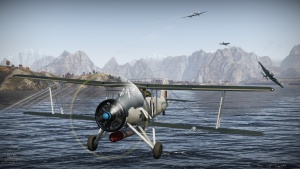
Affectionately known as the "Stringbag" by the pilots, engineers and crews who operated her, the Fairey Aviation Company's Swordfish was a design that was outdated from the very beginning of the Second World War. Despite this, it managed to outlive its replacements, including the Fairey Albacore, in service until the arrival of modern monoplane Torpedo Bombers such as the Fairey Barracuda. Seeing 4 models, plus a float plane modification, the Swordfish would finally bow out of service in 1945 after VE day after showing just how successful the outdated design had become. From the Battle of Taranto, Operations in the Atlantic, to the attack on the Bismarck, the Swordfish struggled on to the end.
Taking to the skies for the first time in 1934, the Swordfish was born into an era that ensured its time would be limited from its very conception, as just one year later in 1935, the Hawker Hurricane and Messerschmitt BF 109 also made their debut. Regardless, the Swordfish would make its mark on history, before its swansong over 10 years after its first flight.
| Archive of the in-game description | |
|---|---|
|
A single-engine biplane of mixed construction, the Fairey Swordfish was developed initially as a Torpedo Bomber/Spotter/Reconnaissance aircraft. The origins of the Swordfish lay in the TSR I prototype of 1933 which, after being lost in an accident, was replaced by the TSR II which first flew on April 17th 1934. The first order for 86 aircraft was placed in April 1935 and in July 1936 the first Swordfish entered service with 825 Naval Air Squadron of the Fleet Air Arm. The Swordfish Mk I was powered by a radial air-cooled Bristol Pegasus Mk IIIM engine and was equipped with one synchronised, fuselage-mounted 0.303 inch Vickers Mk.II machine gun and one 0.303 inch Lewis or Vickers 'K' machine gun in the Telegraphist Air Gunner's cockpit. The Swordfish Mk I could carry one 18 inch torpedo (731 kg), one sea mine (680 kg), three Mk VII depth charges or up to 1500 lbs (680 kg) of bombs underneath the fuselage and wings. Later variants could carry 60 lb rockets. The Swordfish was normally crewed by three; the pilot, the observer and in the rearmost cockpit, the Telegraphist Air Gunner, or TAG. On some occasions the observer would be seated in the TAG's cockpit whilst an extra fuel tank was fitted in the observer's cockpit. As an open cockpit biplane with a fixed undercarriage and areas of fabric skin, the Swordfish was viewed by most as an anachronism and obsolete by the beginning of the Second World War. Nothing could be further from the truth; the Swordfish possessed stable, forgiving handling characteristics which made it ideally suited for naval operations from the unforgiving decks of aircraft carriers in rough seas or at night. With a low stall speed and an incredible agility for an aircraft of its size, the Swordfish could out turn most enemy fighters at slow speeds. It was a tough, robust aircraft capable of withstanding battle damage which would have destroyed many more 'modern' aircraft. It even outlasted its intended replacement, the Fairey Albacore. The Swordfish became immortalised in the annals of naval aviation history when, on the night of 11th-12th November 1940, when 21 Swordfish of 813 NAS, 815 NAS, 819 NAS and 824 NAS carried out a daring attack on the Italian port of Taranto, crippling three Italian battleships and causing significant damage to smaller warships and coastal installations. The attack would become the model for the Japanese Navy's strike on Pearl Harbour. Swordfish of 818 NAS also succeeded in crippling the steering gear of the German battleship 'Bismarck' allowing Royal Navy warships to destroy her. Perhaps the most tragic moment in the illustrious career of the Swordfish was when six aircraft of 825 NAS attacked the German warships 'Scharnhorst', 'Gneisenau' and 'Prinz Eugen' through a screen of anti aircraft fire and squadrons of German fighters. All six Swordfish were lost and their CO, Lt Cdr Eugene Esmonde, was awarded a posthumous Victoria Cross, one of only four ever to be awarded to naval aviators. After a career matched by no other naval strike aircraft in history, production of the Swordfish ceased in August 1944. A Swordfish carried out the last operational flight by a biplane in the Fleet Air Arm in June 1945, leaving only a few of Swordfish to carry out ancillary duties until the last disappeared from the Royal Navy's books in the 1950s. A total of 2,391 Swordfish were produced, 992 of which were from the Mk I series. | |
Media
- Skins
- Videos
See also
Links to the articles on the War Thunder Wiki that you think will be useful for the reader, for example:
- reference to the series of the aircraft;
- links to approximate analogues of other nations and research trees.
External links
Paste links to sources and external resources, such as:
- topic on the official game forum;
- other literature.
| Fairey Aviation Company, Limited | |
|---|---|
| Fighters | Firefly F Mk I · Firefly FR Mk V |
| Bombers | Swordfish Mk I · Swordfish Mk II |
| Export | ◘Firefly F.Mk.IV |
| Britain bombers | |
|---|---|
| Torpedo | Swordfish Mk I · Swordfish Mk II · ▄Avenger Mk II |
| Dive | V-156-B1 |
| Hydroplanes | ▄Catalina Mk IIIa · Sunderland Mk IIIa · Sunderland Mk V |
| Light | Blenheim Mk IV · Beaufort Mk VIII · ▄Hudson Mk V · Brigand B 1 |
| Based on A20 | ▄Havoc Mk I · ▄Boston Mk I · ▄DB-7 |
| Hampden | Hampden Mk I · Hampden TB Mk I |
| Wellington | Wellington Mk Ic · Wellington Mk Ic/L · Wellington Mk III · Wellington Mk X |
| Halifax | Halifax B Mk IIIa |
| Stirling | Stirling B Mk I · Stirling B Mk III |
| Lancaster | Lancaster B Mk I · Lancaster B Mk III |
| Lincoln | Lincoln B Mk II |
| Shackleton | Shackleton MR.Mk.2 |


